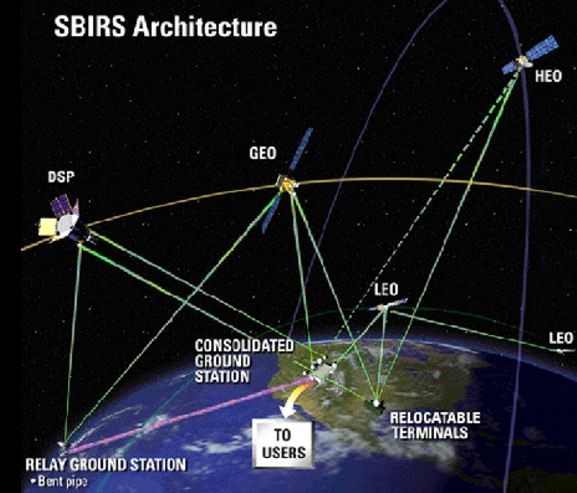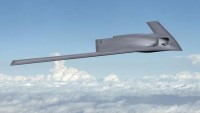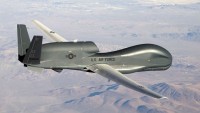New US Missile Warning Satellites Make China’s DF-41 ICBM More Vulnerable
| Arthur Dominic Villasanta | | Aug 09, 2016 08:48 AM EDT |
(Photo : USAF) Configuration of SBIRS: GEO, HEO and Low components.
Lockheed Martin's newest Space Based Infrared System (SBIRS) Geosynchronous Earth Orbit (GEO) satellite to be launched in October will provide the U.S. Air Force with improved detection and tracking of more powerful intercontinental ballistic missiles (ICBMs) such as China's DF-41 (Dongfeng-41).
Like Us on Facebook
The upgraded SBIRS constellation will consist of four dedicated satellites operating in GEO, hosted payloads on two host satellites operating in a Highly Elliptical Orbit (HEO) and ground hardware and software. SBIRS is an integrated "system of systems" designed to better protect the United States from more modern ICBMs with longer range and armed with multiple nuclear warheads.
The newest SBIRS satellite, GEO Flight 3, will launch aboard a United Launch Alliance Atlas V rocket this October. GEO Flight 3 will use infrared surveillance to provide early missile warning. It will be followed in 2017 by GEO Flight 4, which will undergo final assembly, integration and test operations prior to its planned launch.
SBIRS GEO-5 and GEO-6, which are currently in production, will be the new modernized A2100 spacecraft that can incorporate future, modernized sensor suites.
Together, these four new SBIRS satellites enhance the U.S. military's ability to detect missile launches and support ballistic missile defense. It also expands technical intelligence gathering and improves situational awareness on the battlefield.
The first GEO satellite of the SBIRS program, GEO-1, was successfully launched from Cape Canaveral in 2011. It was followed by seven other satellites.
The entire SBIRS constellation is a consolidated system intended to meet the United States' infrared space surveillance needs through the first three decades of the 21st century. The SBIRS program is designed to provide key capabilities in the areas of missile warning, missile defense and battlespace characterization.
The addition of the four new SBIRS satellites will increase the vulnerability of China's DF-41 ICBM to earlier detection and destruction. When it becomes operational, probably within this decade, the DF-41 will be the world's longest ranged missile.
It is believed to have an operational range of 15,000 kilometers, which would place all of the continental United States within reach of this missile and its multiple warheads. The high-hypersonic DF-41 is said to have a top speed of Mach 25 or 31,000 km/h.
This solid-fueled road-mobile ICBM is still in the flight-test stage of development. China began development of this weapon in 1986.
TagsSpace Based Infrared System, SBIRS, intercontinental ballistic missiles, DF-41, GEO Flight 3
©2015 Chinatopix All rights reserved. Do not reproduce without permission
EDITOR'S PICKS
-

Did the Trump administration just announce plans for a trade war with ‘hostile’ China and Russia?
-

US Senate passes Taiwan travel bill slammed by China
-

As Yan Sihong’s family grieves, here are other Chinese students who went missing abroad. Some have never been found
-

Beijing blasts Western critics who ‘smear China’ with the term sharp power
-

China Envoy Seeks to Defuse Tensions With U.S. as a Trade War Brews
-

Singapore's Deputy PM Provides Bitcoin Vote of Confidence Amid China's Blanket Bans
-

China warns investors over risks in overseas virtual currency trading
-

Chinese government most trustworthy: survey
-

Kashima Antlers On Course For Back-To-Back Titles
MOST POPULAR
LATEST NEWS
Zhou Yongkang: China's Former Security Chief Sentenced to Life in Prison

China's former Chief of the Ministry of Public Security, Zhou Yongkang, has been given a life sentence after he was found guilty of abusing his office, bribery and deliberately ... Full Article
TRENDING STORY

China Pork Prices Expected to Stabilize As The Supplies Recover

Elephone P9000 Smartphone is now on Sale on Amazon India

There's a Big Chance Cliffhangers Won't Still Be Resolved When Grey's Anatomy Season 13 Returns

Supreme Court Ruled on Samsung vs Apple Dispute for Patent Infringement

Microsoft Surface Pro 5 Rumors and Release Date: What is the Latest?














